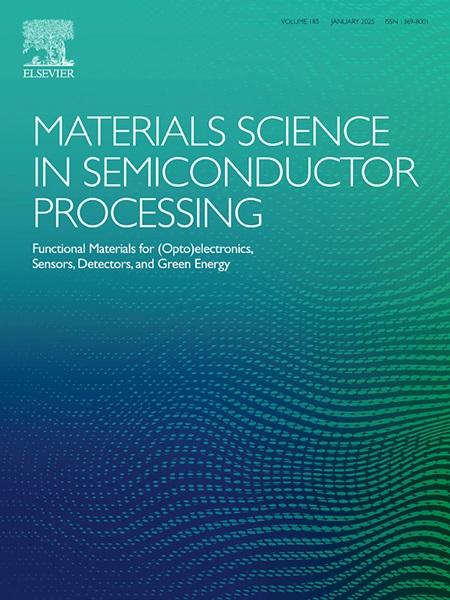A comparative study of threading dislocations in AlGaN/GaN heterostructures grown on Si substrates with different buffer structures
IF 4.2
3区 工程技术
Q2 ENGINEERING, ELECTRICAL & ELECTRONIC
引用次数: 0
Abstract
Effective characterization and suppression of threading dislocations (TDs) via optimized buffer architectures represent critical objectives in developing high-performance GaN high electron mobility transistor (HEMT) electronic devices. This study presents a comparative investigation of TDs characterization in GaN/AlGaN heterostructure grown on Si substrate with two buffer architectures: superlattice (SL) and step-graded (SG) AlGaN. Combining electron channeling contrast imaging (ECCI), defect-selective etching, high-resolution X-ray diffraction (HRXRD), and transmission electron microscopy (TEM), we systematically evaluate both near-surface and bulk threading dislocation behaviors. The integration of ECCI with a Python script enabled automated TD quantification, enhancing measurement precision. All results consistently demonstrate that SL-buffered heterostructures exhibit ∼46 % lower near-surface TD density compared to SG-AlGaN counterparts. Cross-sectional TEM analysis revealed that the discrepancy in dislocation density between two GaN-on-Si epitaxial samples originates from the buffer structure governed stress control and dislocation filtering efficacy, with SL-buffered GaN-on-Si samples demonstrating superior TDs blocking effect and near-surface TD reduction. Our study establishes a framework for efficient and precise TD assessment via multi-technique characterizations, demonstrating superior TD filtering capability of the SL-buffered structure for fabricating high-performance GaN/AlGaN heterostructure HEMT devices with reduced dislocation densities.
不同缓冲结构在Si衬底上生长的AlGaN/GaN异质结构中螺纹位错的比较研究
通过优化缓冲结构有效表征和抑制螺纹位错(td)是开发高性能GaN高电子迁移率晶体管(HEMT)电子器件的关键目标。本研究比较研究了在硅衬底上生长的具有两种缓冲结构的GaN/AlGaN的TDs表征:超晶格(SL)和阶梯渐变(SG) AlGaN。结合电子通道对比成像(ECCI)、缺陷选择性蚀刻、高分辨率x射线衍射(HRXRD)和透射电子显微镜(TEM),我们系统地评估了近表面和体螺纹位错行为。ECCI与Python脚本的集成实现了自动化TD量化,提高了测量精度。所有结果一致表明,与SG-AlGaN相比,sl缓冲异质结构的近表面TD密度降低了46%。横截面TEM分析表明,两种外延GaN-on-Si样品的位错密度差异源于缓冲结构对应力控制和位错过滤效果的影响,其中sl缓冲的GaN-on-Si样品具有优异的TD阻挡效果和近表面TD降低效果。我们的研究通过多种技术表征建立了一个有效和精确的TD评估框架,证明了sl缓冲结构具有优越的TD滤波能力,可用于制造具有低位错密度的高性能GaN/AlGaN异质结构HEMT器件。
本文章由计算机程序翻译,如有差异,请以英文原文为准。
求助全文
约1分钟内获得全文
求助全文
来源期刊

Materials Science in Semiconductor Processing
工程技术-材料科学:综合
CiteScore
8.00
自引率
4.90%
发文量
780
审稿时长
42 days
期刊介绍:
Materials Science in Semiconductor Processing provides a unique forum for the discussion of novel processing, applications and theoretical studies of functional materials and devices for (opto)electronics, sensors, detectors, biotechnology and green energy.
Each issue will aim to provide a snapshot of current insights, new achievements, breakthroughs and future trends in such diverse fields as microelectronics, energy conversion and storage, communications, biotechnology, (photo)catalysis, nano- and thin-film technology, hybrid and composite materials, chemical processing, vapor-phase deposition, device fabrication, and modelling, which are the backbone of advanced semiconductor processing and applications.
Coverage will include: advanced lithography for submicron devices; etching and related topics; ion implantation; damage evolution and related issues; plasma and thermal CVD; rapid thermal processing; advanced metallization and interconnect schemes; thin dielectric layers, oxidation; sol-gel processing; chemical bath and (electro)chemical deposition; compound semiconductor processing; new non-oxide materials and their applications; (macro)molecular and hybrid materials; molecular dynamics, ab-initio methods, Monte Carlo, etc.; new materials and processes for discrete and integrated circuits; magnetic materials and spintronics; heterostructures and quantum devices; engineering of the electrical and optical properties of semiconductors; crystal growth mechanisms; reliability, defect density, intrinsic impurities and defects.
 求助内容:
求助内容: 应助结果提醒方式:
应助结果提醒方式:


